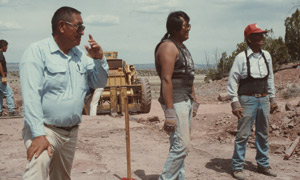Red Ants and Rusted Steel
Edward Crocker
Brilliant ideas come in unlikely ways and at unlikely times. One afternoon I was scouring the Bureau of Indian Affairs' scrapyard at
Zuni Pueblo for usable junk when Paul Neha wandered up. The approach was casual, but we spent the next five hours sitting on rusted steel
while he described a vision for the future of his community. The approach may have been nonchalant but the purpose was not.
I wasn't in the BIA's boneyard only because I like old stuff with moving parts, which I do, or because I could just show up and fondle
the obsolete remnants of federal property that tribes collect. I was there because I needed some passive iron plate for part of a shoring
system that I had contrived for the decrepit, earthen, Nuestra Señora de Guadalupe church just south of the main dance plaza. By the time
Paul and I forced our way out of the locked chain-link gate, I was carefully eying something less passive than plate; a massive old
Euclid loader fitted out as a forklift.
 Paul was Red Ant Clan. He liked rocks, and I suppose that when comparative scale is considered, he liked rocks that were about the
same size as those found in abundance in the hills that lent his clan their eponym. What he had in mind was to re-open the historic stone
quarries and give Zuni back an architecture made from local materials. It was a brilliant idea, and it worked.
Paul was Red Ant Clan. He liked rocks, and I suppose that when comparative scale is considered, he liked rocks that were about the
same size as those found in abundance in the hills that lent his clan their eponym. What he had in mind was to re-open the historic stone
quarries and give Zuni back an architecture made from local materials. It was a brilliant idea, and it worked.
The Zunis had pretty much lost the art of stone masonry by the time Paul and I had our talk. The last time it had been practiced in
earnest was over two generations past, and much is lost in a very short span where traditions are concerned. What Paul knew was that
only two elderly men remained who not only had the craftsmanship to work the local red sandstone, but who also remembered the special
prayers and offerings that made the endeavor a specifically Zuni one. (I have written about that aspect previously in this column: See
The Magic of Earth and Whence Tradition?)
I shopped Paul's idea around and found instant support within the pueblo and among many in the business of giving money for
architectural conservation. I also found that re-opening the stone quarries in a training context was the easiest sell I had ever
attempted. The result was that six years later, the elders who knew the trade had trained some 150 young Zunis in their craft.
To the outsider, the effect has been spectacular; the east side of the dance plaza that was void of buildings for years after a collapse has
been rebuilt, and all of the homes around "Center Place" now have flat, tiered roofs above beautifully dressed stone walls. Those have
replaced frame structures and pitched roofs that had accreted over the years and distracted immensely from the attraction of the place.
Paul Neha is gone now, and so are the two elders to did the training. I am happy to report that the trainees are now the leaders, and that
the quarries are still operating. All it took to make it happen was an afternoon visit with a visionary red-ant on a pile of rusted steel.

